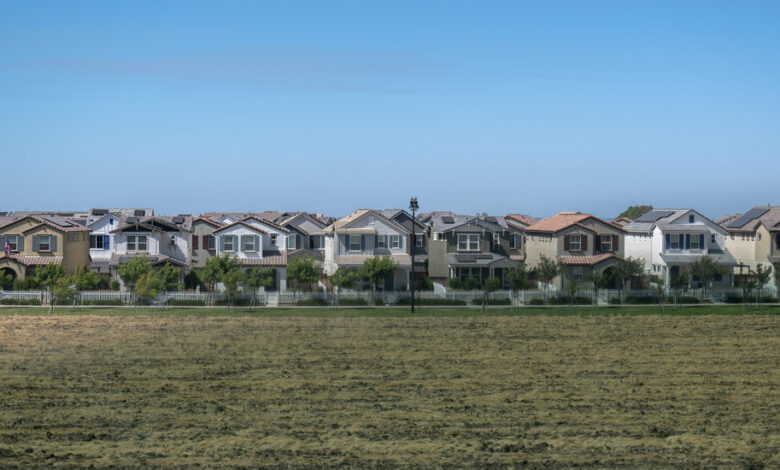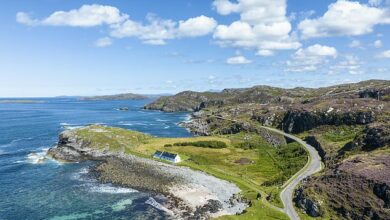Some Californians have found dream homes in the interior. But it’s hot there.

When Farwa Ali and her family wanted to buy a bigger home, Mountain House in California seemed to fit all their needs.
The fast-growing community, just 40 miles inland from where they lived in the San Francisco Bay Area, offered good schools, a diverse population and dozens of large homes for sale within their budget. It seemed like a perfect fit — at least until their first summer, when the scorching temperatures of California’s Central Valley hit.
“We never thought it would be this hot,” Ms. Ali said on Tuesday as she ran through a supermarket parking lot where temperatures were well above 100 degrees.
Mountain House, about 60 miles east of San Francisco, became California’s newest city on Monday after voters approved in the spring to give their bedroom community a full-fledged government with a mayor and city council. What began as a small suburban development has been propelled in recent years by a surge of homebuyers priced out of the Bay Area.
Inland cities have been attracting coastal Californians for years, but the migration accelerated after the pandemic, when many workers could work remotely from anywhere and families wanted more living space.
One of the downsides of moving inland is the oppressive heat waves that are rarely felt near the California coast. Climate change is intensifying the hot spells, exposing more newcomers to extreme temperatures.
The latest test came this week, as the first extended heat wave of the summer gripped parts of the state. Extreme heat is expected to last for days; in Mountain House, temperatures were expected to reach 110 degrees on Wednesday and could remain above 100 degrees well into the week.
As the sun began to bake Mountain House this week, the newly incorporated city canceled youth practices for tennis, golf and flag football. Construction workers, landscapers and garbage collectors rearranged their schedules to work earlier in the day. Most residents stayed indoors.
The name Mountain House may suggest an elevated spot in cooler air, but the city gets the same scorching heat as the rest of the Central Valley in the summer. It sits at the base of the Altamont Pass, which commuters have traversed for decades to reach their Bay Area workplaces, passing giant wind turbines that are part of California’s clean energy efforts.
Mountain House was founded in 1996 on former alfalfa fields. In 2008, falling home prices during the financial crisis made Mountain House “the most underwater community in America,” The New York Times wrote at the time.
However, California housing prices have skyrocketed since then, and a new wave of people moving to Mountain House has brought young families and greater ethnic diversity to the community. About half of the town’s 25,000 residents identify as Asian American, according to a 2022 census.
Andy Su, the new mayor of Mountain House and an emergency room physician, said the heat hasn’t been an overwhelming concern at the nearby hospital where he works, Sutter Tracy Community Hospital. While he has seen an unusually high number of patients with kidney stones caused by dehydration, he said he doesn’t see many other heat-related illnesses.
“When people move here, they make the decision, they know what they’re getting into,” Dr. Su said. “It’s warm, but we adapt our lives to it — just like when you live in Alaska, you adapt your life in the winter.”
Kevin Costa, a solar technician, has outfitted his Mountain House home with large overhangs and dark window treatments. In weeks like this, he runs fans, cranks up the air conditioning and avoids the garage, which is “like an oven,” he said.
On the hottest days, he said, he puts a wet towel behind his neck or soaks his shirt in cold water before leaving the house. Even then, he said, “it feels like a hair dryer constantly blowing hot air at you.”
Some Mountain House residents said this week that they are used to similarly warm weather in their hometowns in India, Pakistan or the Philippines.
When the heat hits, Ms. Ali, originally from Bangalore, India, said she changes her family’s diet and makes traditional dishes that help them stay cool. Her hot-weather recipes include yogurt, okra and gourds, and she leaves out red meat and chicken. “I’m still not sure if it really works in this extreme heat,” she said.
For some residents there are few options to survive.
Daniela Soto and her two sons moved to Tracy, the next city east, in search of cheaper rent after living in the bayside city of San Leandro, Calif., and in New York. She still can’t afford to run her air conditioning, she said, so she took her boys to a water park in Mountain House on Tuesday.
She said she’d like to move to a cooler city in California, but that possibility seems increasingly out of reach.
“They’re going to be expensive no matter where you go,” she said. “It’s almost like you’re trapped in this hot bubble.”
Judson Jones contributed to the reporting.




